Isfahan Tourist Attractions
Ghasr-e Monshi Boutique Hotel in Isfahan
Ghasr-e Monshi Palace, located in the heart of Isfahan’s historic district, is a beautiful boutique hotel that blends history with luxury.
Read moreFire Temple of Isfahan | Atashgah-e Isfahan
The Fire Temple of Isfahan is an ancient relic from the Sassanid period that offers visitors a blend of history, spirituality, and stunning natural views.
Read moreKurd-e Olia Underground City in Isfahan
The underground city of Kurd-e Olia is a fascinating labyrinth of tunnels and chambers carved deep beneath the surface, offering a glimpse into the ingenuity of ancient architecture of Iran.
Read moreHoney Festival in Khansar: A Honey Lover’s Dream Destination
Honey festival in Khansar celebrates not just the golden nectar, but the centuries-old traditions of beekeeping woven into the town’s culture.
Read moreIsfahan Music Museum: A Must-Visit for Music Lovers
Isfahan Music Museum is a labor of love, featuring a vast collection of national and folk instruments assembled by a private collector.
Read moreJolfa Neighborhood: The Armenian Quarter of Isfahan
Jolfa is one of the most beautiful and historic neighborhoods in Isfahan. Unlike traditional Iranian streets, Jolfa's distinct charm resembles the streets of Europe, with its elegant cobblestones, unique house architecture, and small fountains lining the streets, captivating every passerby.
Read moreShahrestan Bridge in Isfahan: Iran’s Oldest Historical Bridge
The Shahrestan Bridge in Isfahan, Iran, is one of the oldest bridges in Iran.
Read moreImamzadeh Ismail: A historic Safavid Era Shrine in Isfahan
Imamzadeh Ismail is a remarkable historical and religious complex located in Isfahan, Iran. This site is believed to be the resting place of Imamzadeh Ismail and prophet Isaiah, one of the prophets of Israelites.
Read moreHakim Mosque of Isfahan | A Masterpiece of Safavid Architecture
Isfahan is renowned for its stunning Iranian architecture, including its distinctive mosques, minarets, mansions, and historic bridges. Among its many architectural gems is Hakim Mosque, also known as Jorjir Mosque, which stands as a testament to the city's rich artistic heritage.
Read moreIsfahan's Dardasht Minarets and Soltan Bakht Agha Mausoleum
The Dardasht Minaret is a historic monument located in Isfahan, Iran. This architectural marvel stands over the Soltan Bakht Agha Mausoleum, the niece of Shah Sheikh Abu Ishaq, a ruler of the 8th century Solar Hijri calendar.
Read moreSheikh Abdolsamad Mosque in Natanz, A 14th-Century Masterpiece
Sheikh Abdolsamad Mosque also known as the Jameh Mosque of Natanz, is a remarkable example of Persian architecture from the Mongol Ilkhanid period. Located in Natanz, Isfahan province, the mosque is deeply intertwined with the life of Abdul Samad al-Isfahani, a revered Sufi ascetic.
Read moreBaba Ghassem Mosque: Isfahan's Iconic 14th-Century Site
Baba Ghassem Mosque, also known as Baba Ghassem Mausoleum, is a significant historical site located in the historic Ibn Sina neighborhood of Isfahan, Iran.
Read moreSaru Taqi Mosque - A Site With A Rich Safavid Architecture
Isfahan is renowned for its grand mosques, palaces, and historical splendor, and hides within its bustling streets a lesser-known yet fascinating historical treasure: the Saru Taqi Mosque.
Read moreAshraf Hall in Isfahan: A Safavid Era Marvel
Isfahan is celebrated for its remarkable Persian architecture, reflecting centuries of cultural and artistic heritage. One of the most striking monuments from the Safavid era is Ashraf Hall, a testament to the grandeur and aesthetic sensibilities of that period.
Read moreMesr Desert in Iran | Fabulous Desert
Mesr, named for its Persian meaning "Egypt," is a desert village situated in the Central District of Khur and Biabanak County, Isfahan province. It lies 45 km from Jandag and 371 km from Yazd.
Read moreIsfahan's Atiq Square | A Historical Crossroad
Atiq Square, also known as Isfahan Kohneh Square, Sabze Meydan or Imam Ali Square, is a historic landmark in Isfahan, Iran. Located in the city center, it's a popular tourist destination.
Read moreMaranjab Desert: A Spectacular Natural Attraction in Iran
Deserts are amongst the best places in the world for adventure. From treks across incredible landscapes, to gazing at the stars on a pristinely clear night.
Read moreIsfahan Traditional Bazaars | A Shopping & Cultural Adventure
Isfahan, Iran's third-largest city, possesses a rich history and cultural heritage, attracting a significant number of tourists each year.
Read moreTakht-e Foulad | Gateway to Iran's Past
Among Isfahan's many treasures lies Takht-e Foulad, a significant historical site that has witnessed centuries of Iranian history unfold.
Read moreMonar Jonban: The Mystery of Iran's Shaking Minarets
If you ever find yourself in the city of Isfahan, Iran, you may come across a remarkable architectural wonder known as the “Monar Jonban, in Farsi منار جنبان” or the Shaking Minarets.
Read moreMasjed-e Jame of Isfahan | History, Architecture, & Travel
Jame Mosque of Isfahan (مسجد جامع اصفهان), commonly referred to as the Friday Mosque (مسجد جمعه) or Atiq Mosque (مسجد جامع عتیق), is a distinguished monument situated in Isfahan, Iran.
Read moreIsfahan Historical Palaces | Architectural Marvels
As one of the oldest cities in the world, Isfahan has played a pivotal role in shaping the cultural and architectural landscape of Persia.
Read moreSiosepol Bridge | 33 Archs on Zayandeh Rud
Isfahan, often referred to as "half of the world" in the Persian proverb "Isfahan Nesf-e Jahan," stands as a city steeped in cultural and historical significance.
Read moreGhoortan Citadel | Desert Fortress of Legends
Located in the heart of Isfahan province, Iran, lies the historically significant Ghoortan Citadel, an architectural marvel resonating with tales of the past.
Read moreAbyaneh Village | A Must-Visit Destination
Abyaneh Village, is where time seems to stand still amidst its crimson-hued buildings and storied cobblestone streets.
Read moreSheikh Lotfollah Mosque | A Masterpiece of Persian Architecture
The Sheikh Lotfollah Mosque, located in the heart of Isfahan, Iran, is a true masterpiece of Islamic architecture.
Read moreExploring Ali Qapu Palace in Iran
Ali Qapu Palace, a splendid jewel nestled in the heart of Isfahan, Iran, stands as a testament to the grandeur of Persian architecture and history.
Read moreShah Mosque, Isfahan | A Complete Visitor Guide
Isfahan, often referred to as "Nesf-e Jahan" (Half of the World), is a city with a long history, and the Shah Mosque (Masjid Imam) is right in the middle of it.
Read moreNaghsh-e Jahan Square: The Heart of Isfahan, Iran
Naghsh-e Jahan Square, located in the heart of Isfahan, Iran, stands as an extraordinary testament to the grandeur and artistic ingenuity of the Safavid dynasty.
Read moreChehel Sotoun Palace: Iran's Timeless Marvel
Isfahan is known for being a city characterized by numerous exquisite gardens, historic bridges, and palaces. The majority of these landmarks boast a history spanning at least a century.
Read moreVank Cathedral | Persian & Armenian Cultural Masterpiece
Vank Cathedral, an architectural gem nestled in the heart of Isfahan, Iran, stands as a testament to the rich history and cultural diversity of the region.
Read moreTop 9 Persian Gardens | UNESCO World Heritage Sites
“Iranian love for trees and flowers has gradually turned into an eternal love which has manifested itself in Persian Gardens”.(Arthur Pope)
Read moreAbyaneh Mysterious Historical Village
gine going for a stroll around an animated Disney town or village. What a thrilling prospect! Visit lovely Abyaneh to make it a reality rather than dream it!
Read moreBest Hotels in Isfahan to Stay
Isfahan is a famous Iranian city known by many titles, such as "the gem of the Islamic world".
Read moreIsfahan's Khaju Bridge, Everything You Need to Know
In its day, the Khaju Bridge was regarded as one of the most stunning bridges in the world, making it one of Isfahan's historical and aesthetic wonders.
Read moreIsfahan Mosques You Should Visit
Isfahan has a long history of being renowned for its abundance of mosques.
Read moreAbbasi Hotel in Isfahan - All You Should Know
Isfahan is an ancient city with a rich history and much to convey.
Read moreBest Restaurants in Isfahan
One of the most crucial aspects is where and what you eat on your trip.
Read moreBest Dishes in Isfahan You Must Try!
In every Iranian city, visitors will encounter various cultures and customs, all of which will appeal to and please them.
Read moreTop 10 hotels Nearby Naghsh-e Jahan Square in Isfahan
The city of Isfahan is one of the most popular and visited cities in Iran due to the stunning bridges over Zayandeh Rood, magnificent gardens, numerous historic sites, and especially delicious cuisine and delightful desserts.
Read moreMenar Jonban | The Historical Shaking Minaret
Isfahan is one of the oldest and most visited cities in Iran by both locals and international tourists. In addition to a number of beautiful sightseeing and historical monuments, you can always treat yourself with some of the best local food, and mouthwatering desserts.
Read moreVank Cathedral: One of the Oldest Christian Cathedral in Iran
Being an Islamic country, there are a number of mosques and holy shrines in every corner of Iran. However, for centuries, people from other religions have been living in the country, and as a result, it is easy to find religious places of other religion.
Read moreTop 5 Bridges in Isfahan over Zayanderud River
Isfahan is one of the most visited cities in Iran, not only by locals but also by international tourists coming to the country. There are a number of monuments, historical houses and palaces, and local bazaars and shops to visit in the city.
Read moreIsfahan Travel Guide | Top Tourist Attractions
There are a number of cities in Iran which are very popular for both local and international tourists, and Isfahan is on the top of that list due to its stunning bridges over Zayand-e Rood, magnificent gardens, numerous historical sites, and especially delicious cuisine and delightful desserts.
Read moreHasht Behesht Palace: The Entrance to the Promised Paradise
While the city of Isfahan, has a dry climate and located at the edge of the desert, there are a number of gardens, beautiful roses, and shades of trees in the city. In addition to numerous historical sites in Isfahan which always visited by tourists when they travel to Isfahan, there is a small, beautiful palace at the center of the garden, called Baghe Bolbol.
Read moreChehel Sotoun Palace; A Persian Garden with Mural Paintings
Isfahan is known as a city with numerous beautiful gardens, historical bridges, and palaces. Most of these monuments have a history for at least for a hundred years.
Read moreTop 7 Distinct Hotels in Iran
There are so many historic and traditional hotels all over Iran. However, some of them are exceptional for their architecture, beauty, or the history of the place. In this article, we are going to introduce some of the most distinct hotels in Iran to give you an idea about these magnificent places.
Read moreTop 9 Places to Visit in Isfahan
Isfahan is one of the most magnificent cities in Iran with lots of beautiful and historical sites to visit. There are numerous palaces, bridges, mosques, and bazaars in the city which for sure no tourists have enough time to visit all of those. In this article, we are going to introduce the best places to visit in Isfahan to make sure that you do not miss any.
Read moreMasjed-e Jame of Isfahan
If you are planning to travel to Iran and visit Isfahan, one of the must-see monuments of the city is Masjed-e Jame of Isfahan. Actually, a travel to Iran and travel to Isfahan is not completed without seeing this amazing place.
Read moreNaghsh-e Jahan Square | The Square with Magnificent Architecture
Naghsh -e Jahan Square (Naghsh stands for Image and Jahan for the World), is situated at the center of Isfahan city.
Read moreMesr Desert in Iran | Fabulous Desert
Mesr (it has the same meaning as Egypt in Persian) is a desert village in the Central District of Khur and Biabanak County in the Isfahan province and 45 km far from the city of Jandag and 371 km far from Yazd.
Read moreIsfahan | The City of Gardens
Isfahan is the most visited city by international tourists in Iran for its stunning bridges over Zayanderud, magnificent palaces, beautiful gardens, wonderful mosques, lots of historical sites and also the Armenian church in Jolfa district.
Read moreIsfahan Tourist Attractions
There is no mystery as to why Isfahan is Iran's most popular tourist attraction. As the old Persian saying goes, "Isfahan Nesf-e Jahan," meaning "Isfahan; Half the World". The third-largest city in Iran is Isfahan, one of the country's most important cultural centers and former capital at several points in its lengthy history; stunning bridges, kind natives, and a wealth of undiscovered destinations are all features of ancient Islamic architecture.
Even without mentioning all the food, that is Biryani (hamburger that contains sheep's pluck, lamb, and onion), Khoresh-e mast (a dish made from yogurt, meat, and saffron), and Kaleh Joosh (Mint, onion, walnut, and curd). The list goes on and on. You may try them all in Isfahan, which is nothing short of amazing. Isn’t it fantastic? Later in this article, we also will mention the best places to try Isfahan cuisine. So, when you visit Isfahan, don't forget to indulge yourself in some of these delicious meals. What are the best things to do in Isfahan? Continue reading to learn more about Isfahan attractions, this medieval city in central Iran has much imposing Persian architecture, palaces, mosques, bridges and gardens, mosaic-tiled domes and minarets, and more marketplaces than we could possibly count.
Here we go:
Top 16 Isfahan Attractions
1. Naqsh-e Jahan Square
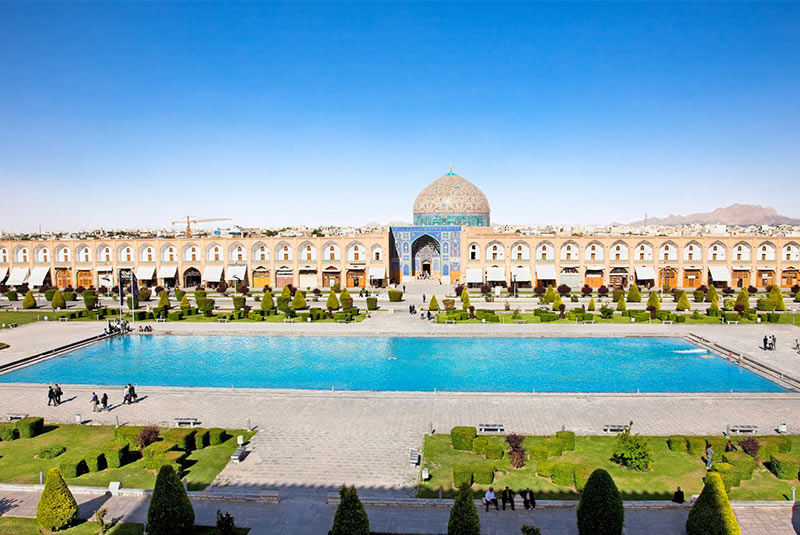
The site is famous for the Royal Mosque, the Mosque of Sheykh Lotfollah, the magnificent Portico of Qaysariyyeh, and the 15th-century Timurid Palace. It is one of the most excellent Isfahan historical places. It was built by Shah Abbas I the Great at the beginning of the 17th century and is bordered on all sides by monumental buildings connected by a series of two-story arcades. They provide a striking illustration of the sophistication of Persia's social and cultural life at that time. This square is around 165 meters wide and 500 meters long from north to south. The Ali Qapoo Edifice, the Qaisarieh gateway, and the Abbasi and Sheikh Lotf Ol-lah Mosques are all nearby. During the rule of Shah Abbas I and his successors, this square served as a venue for celebrations, polo matches, theatrical performances, and military parades. The loveliest souvenirs of Isfahan, such as Mina, Khatam, Mes (copper pots, Firuze (turquoise)), and Ghalamkarie, may be seen and purchased in this enigmatic, classically oriental, magnificent square, which is surrounded by thousands of stores. You might ride in a horse-drawn carriage there. Do not forget that Naghsh-e-Jahan Square is the first must-see attraction in Isfahan.
2. Imam Mosque (Shah Mosque)
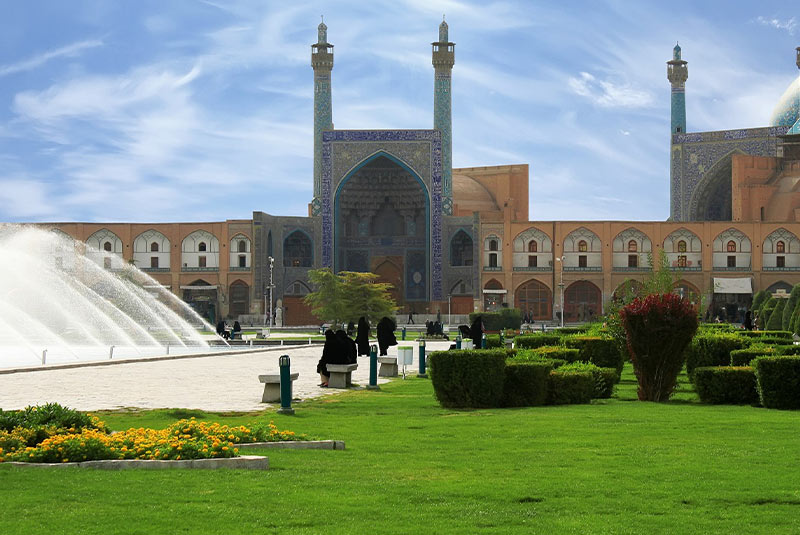
The Masjid-e Imam, also known as Jame Abbasi Mosque, Masjid Soltani, and Royal Mosque, was once known as the Masjid-i Shah (Shah Mosque). It is recognized as a masterpiece of Islamic-era Persian architecture, positioned next to Naqsh-e Jahan plaza in the center of the city of Isfahan. This mosque, which was constructed during the Safavid era under the leadership of Shah Abbas, the Safavid King, is regarded as one of the most significant Isfahan historical places. It is also the most significant example of Persian architecture from the Islamic era; that is why the Imam mosque is one of the most popular Isfahan attractions. This building is the ultimate example of architecture, tiling, and carpentry.
The Shah Mosque was listed as a National Monument of Iran in 1931. It was included in Naqsh-e-Jahan Square's list of UNESCO World Heritage Sites. Right in the center, directly beneath the central dome, is a stone that does not match the surrounding rocks. This stone designates the Shah Mosque's crucial acoustic location. The Imam may pray at a lesser volume while still being heard by everyone in the mosque since the sound reverberates powerfully from this location throughout the remainder of the structure. You can try out the characteristic for yourself by, for instance, stomping on the stone, clapping your hands while standing on the stone, or dropping a book on the stone. You'll hear the loud sound resonating throughout the mosque, which appears to be tested by many of the mosque's tourist visitors.
3. Ali Qapoo Palace
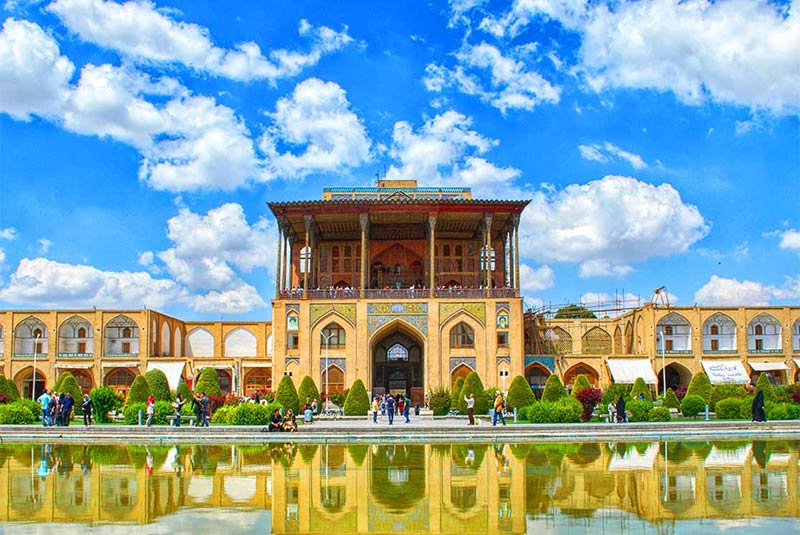
The Alighapoo Palace was also known as the Daulat Khaneh Palace and the Daulat Khaneh-e-Mobarakeh Nagsh-e-Jahan. The Safavid era is associated with its distinctive antique architecture. Shah Abbas I gave the order to build this structure. The palace served as the monarch's meeting place and as a place to receive special envoys. Here, one may find priceless miniature paintings, the creations of renowned contemporary artists like Reza Abbassi, as well as other conventional pieces of art. The "sound room” plasterwork was designed such that the acoustic effect generated natural and enjoyable noises.
From the halls of this opulent castle, the emperor and his guests could watch polo, illuminations, fireworks, and the dramatic events occurring in Naghsh-e-Jahan Square. The hall's 18 columns are covered with mirrors, and the ceiling is embellished with magnificent murals. On the first level is where the chancellery was located. The royal dinners and festivities were held on the sixth. On this floor, the most significant rooms are located. The dinner hall's stucco ornamentation is rich with different cups and dishes patterns. The Music Hall was the common name for the sixth floor. At this very attraction of Isfahan, various groups play music and sing songs while exploring eye-catching views.
4. Sheikh Lotfollah Mosque
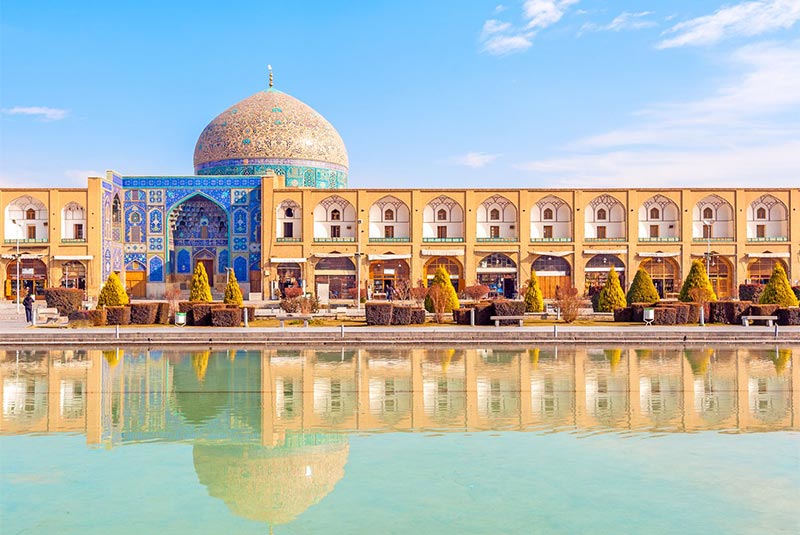
On the eastern side of Naghsh-e Jahan Square is where the Sheikh Lotfollah Mosque is located. This mosque was erected during the reign of Shah Abbas and was dedicated to his father-in-law, Sheikh Lotfollah, a revered religious figure who arrived in Isfahan on the king's instructions and lived nearby but was not engaged in the mosque's building. He belonged to the Imami, or Shi'ite sect, like his family and was encouraged to settle in Iran by the Safavid dynasty as part of their strategy to spread Shi'ism throughout the country, along with other Imami followers from Bahrain. It took over 20 years to build this exquisitely proportioned and embellished mosque with some of that period's most excellent mosaics. The mosque is distinctive since it lacks a Minaret and a courtyard, and the delicate tiles of the dome change color depending on the lighting, from cream to pink.
At certain times of the day, the painted image in the center of the floor beneath the dome resembles a peacock. The sunshine enhances the peacock's tail. Due to a tunnel between this mosque and the Ali Qapu palace, the mosque was formerly known as the Ladies' Mosque, allowing women from previous dynasties to attend prayers covertly. The gateway Eyvan (Farsi) is preceded by a recessed small court that runs from Naghsh-e-Jahan Square and is connected, on its north and south sides, to the continuous corridor that encircles the square's mercantile facilities, rather than being aligned with the height of the yard. The mosque's main entrance is situated on the east side of this small court. The building is angled (nearly 45 degrees) toward the eastern wall of the square rather than perpendicular to it. This causes the mosque's main portal, Eyvan, and dome, which usually fall on the same axis as other mosques, to not be visible from the square. Instead, the dome appears behind the main portal Eyvan as if it had shifted 6.5 meters to the right off its axis.
This structure's asymmetrical design, which was originally used to balance the mihrab's location on the qibla wall with Mecca's (southwest) orientation, adds aesthetic intricacy. The dome, which has a three-level construction, is a rare single-shell dome seen in Safavid architecture. A dome made up of sixteen arched panels is supported by four squinches of pointed-arched panels that rise from the floor and are framed by an inscription band in white and blue that is delineated by light blue cable moldings. An arabesque pattern of alternating double-grille windows decorates the dome. The Sheikh Lotfollah mosque, notable for its position, scale, architecture, and adornment, is regarded by historians and tourists as one of the most significant architectural undertakings constructed in Isfahan's Square. It serves as the most exemplary illustration of Iranian architecture and tile craftsmanship from the 17th century. Its buff dome's splendor enchants tourists with its beauty. This mosque is unique from all others in several ways.
5. Isfahan Grand Bazaar (Qasariyeh)
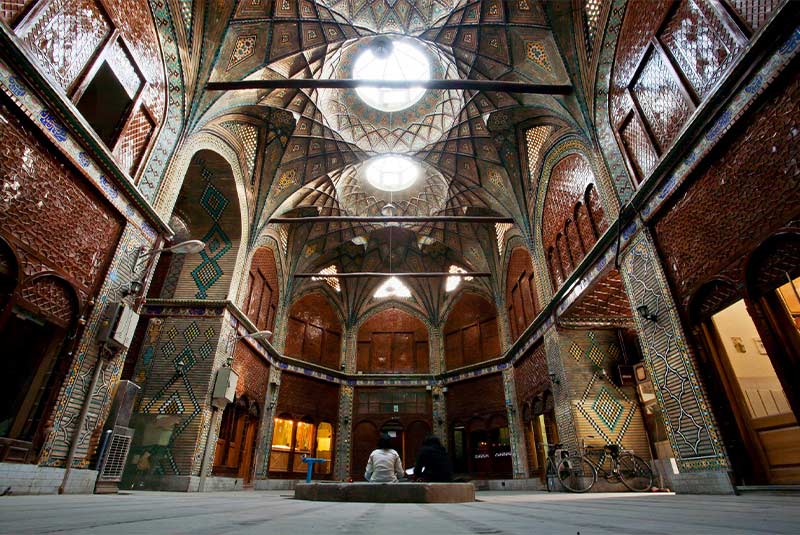
Isfahan is an ancient city with historical significance to Iran, and its bazaar has evolved over time. All structural elements of medieval Iranian bazaars may be demonstrated through an analysis of the Isfahan Bazaar. It highlights the institution-building and social-integration functions of bazaars throughout Iranian history. The Isfahan bazaar, which extends from the Qasariyeh front to the Jame' Mosque, is a remnant of the Safavid era. This bazaar served as one of the region's most opulent commerce hubs during the Safavid era.
Numerous ancient structures, including the Nimavar School, Sadr School, Khayyatha Mosque, No Mosque, Zolfaghar Mosque, Shishe Mosque, and Jarchi Mosque, can be found in the Qeysarie Bazaar. The bazaar's primary entrance is the Qeysarie gate. (The sale of carpets and kilims is the principal business activity at the Qeysarie market.)This large bazaar with its old stores is a location of architectural significance because of its traditional and historical design. Along with exploring Isfahan attractions, everything one may expect to find is available in the stores, including copper jars, handicrafts, clothing, textiles, gold, food, spices, shoes, rugs, souvenirs, and decorations. It's fascinating to note that there is a small market with hundreds of shops for each item.
Isfahan Handicrafts and Souvenirs
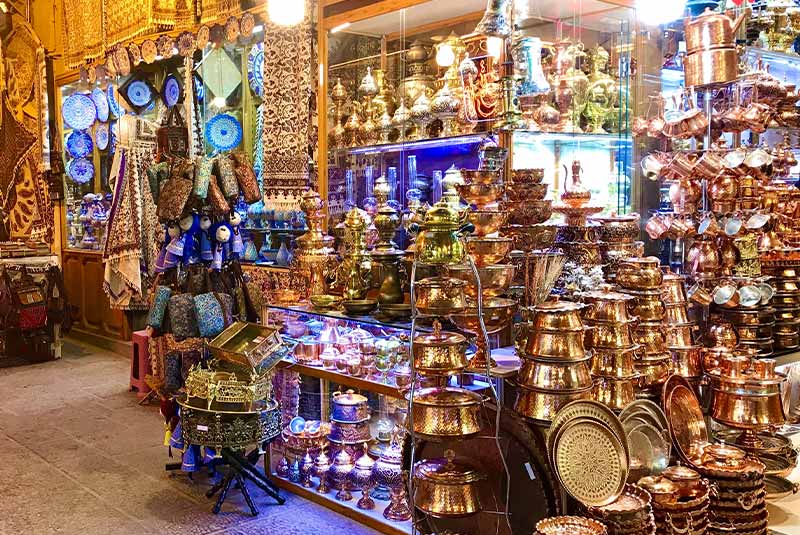
Isfahan has been a significant Persian arts and crafts center for many years. The handicraft industry in the province of Isfahan is substantial in this regard due to its reputation. Specialties from other Iranian regions are also manufactured here in addition to its own regional goods. Handicrafts are obviously crucial in this region, given how famous this province is with tourists.
The followings are the most significant Isfahan handicrafts and souvenirs:
Brocade weaving
Enamel work
Ceramics
Carpet weaving
Kilim (or a coarse carpet)
Khatam (inlaid work)
Silverwork
Engraving on metal
Tiles
Jewelry making
Many sweetmeats, such as "Gaz" and "Sohan."
6. Jamea Mosque of Isfahan

Masjid-e Jameh, also known as the Atiq Mosque and located in Majlesi St, is one of Persia's oldest and most famous buildings. This incredible attraction of Isfahan is attributed to a collection of buildings and artwork from Iran's post-Islamic era. Small platforms to the right of the entry hallway, circular pillars, and lovely plasterwork are intriguing features of this mosque. These are the remains of the fourth-century AH Deylamite civilization; The Dome of Khajeh Nezam-ol-Molk (minister during the reign of Malek Shah Seljuk). The mosque's integration with the city is another distinguishing feature. The mosque, which is located in the heart of the ancient city, is surrounded by other structures on all sides by walls. It served as a pedestrian center for the city's arterial network of routes because of its enormous size and multiple entrances (all but one of which are now inaccessible).
The mosque went beyond its primary purpose as a site for prayers alone by facilitating public movement and commercial activities. It was far from being an isolated holy monument. The interior décor is quite intricate despite the exterior's simplicity in earth tones. The soffits (undersides) of domes are made in a variety of geometric patterns and frequently have an oculus, a circular sky-facing aperture. When ribbed, vaults can provide ventilation and lighting in otherwise grey areas. The mosque complex, surrounded by four enormous Evans, or arched recesses, has buildings dating from the 11th to the 18th centuries, including private chapels, schools, libraries, and treasuries.
7. Chehel Sotoun Palace
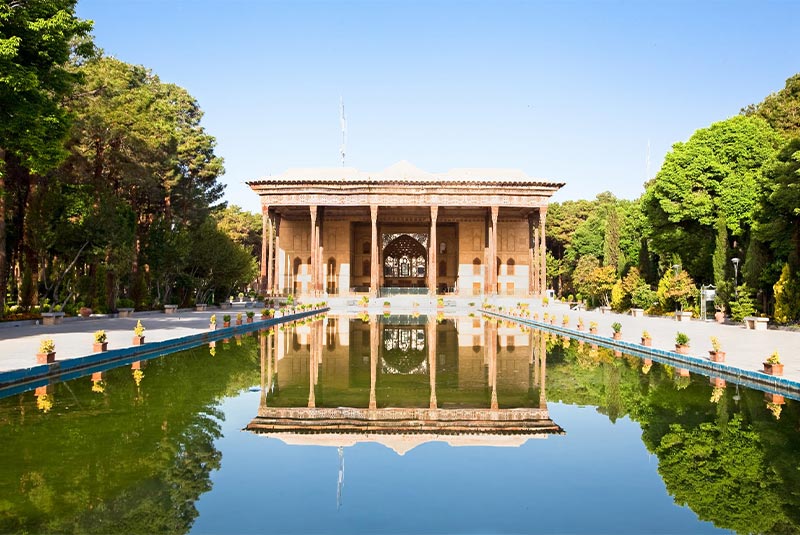
The Chehel Sotoun Palace and its grounds area is around 67,000 square meters. Shah Abbas I oversaw the construction of this palace. The hall of mirrors, the hall with 18 pillars, and two sizable rooms facing north and south were all additions to this palace made by Shah Abbas II. The magnificent hall of mirrors, with its adorning tile work, paintings, and mirror work, as well as its regal porches and pool that front this hall, all add to its beauty. The Chehel Sotoun Palace is one of the ever most visited Isfahan tourist attractions. A marble hall surrounds the center pool with arched cornices and stone lions at each of its four corners. Chehel Sotoun Palace wall paintings, golden decorations, and the monarch's picture in the royal hall; likewise, those of the rooms that enclose the hall of mirrors.
The miniatures in the treasure chamber include the picture of Shah Abbas I with the distinctive crown. The palace's main hall, which is reserved for foreign visitors and notable foreigners, is decorated with paintings depicting historical events from various eras. This beautiful hall, built around a dome, is distinguished by colorful lofts and gilded, translucent decorations that pay homage to the period's greatest works of art. The main lines of the divisions of the building, which are a combination of paintings, tiles, and other various decorations, and the combined plan walls and ceiling of the hall, which are located in the lovely form of Lechak and Toranj, make this magnificent work in the form of one of the most notable examples of Safavid era architecture in Chehelsotun's historical monument.
8. The Khaju Bridge (Pol-e Khajoo)
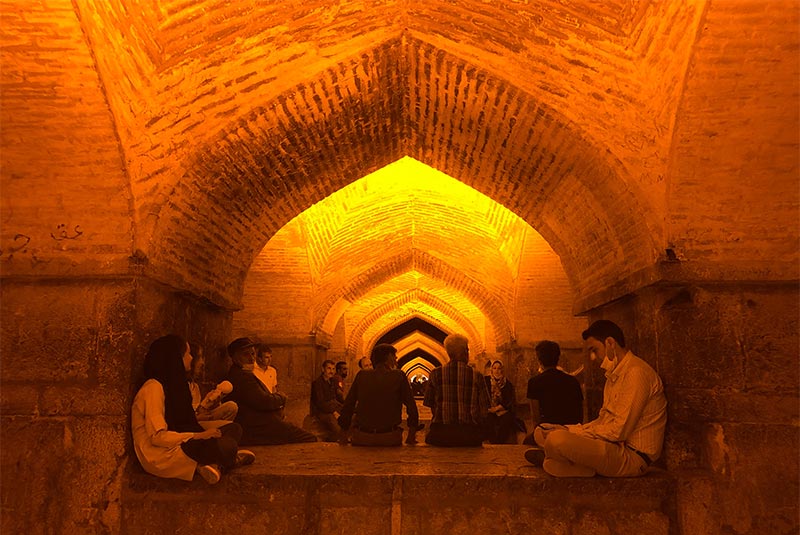
One of Iran's most well-known bridges, the Khaju Bridge, was constructed on the remains of an earlier bridge in the early 1650s during the reign of Abbas II, the seventh Safavid ruler (Shah) of Iran. The inscriptions still in place imply that the bridge was restored in 1873. The most beautiful bridge in Isfahan is the Pole Khaju or Shahi Bridge. Shah Abbas II, the Safavid king of Persia, ordered the construction of this bridge in 1650. It serves as a structure and a location for public gatherings and as a bridge and a weir. Beautiful murals and exquisite tilework adorn this bridge. Shah Abbas (King Abbas) once sat on a pavilion in the middle of the building to take in the view. However, all that is left of the king's chair is the stone seat. The construction's cubicles, decorations, and tile work are all intriguing features.
The Beglarbegi structure is a building that is located in the middle of the bridge. The royal family temporarily stayed in the same place. The term "Khajeh," which was a title for notable individuals during the Safavid era, is twisted in the name of this bridge. On the Zayandeh Rood River, it was built. The bridge now features artistic artwork and exquisite tilework. Even though it was built 350 years ago, the bridge is still in operation. It serves as a place for social interaction, culture, and relaxation. Everyone is immediately drawn to the magnificent arches inside the bridge, especially at night when bright lights illuminate them.
9. Sio Se Pol Bridge

Si-o-se-pol bridge (33 bridges or Allahverdi Khan Bridge) is a stone double-deck arch bridge over the Zayanderud River that is about 300 meters long and 14 meters wide. It is one of the greatest works of bridge architecture in Iran and the entire globe. A notable Shah Abbas Safavid I commander, Allah Verdy Khan, oversaw and paid for the construction of the same structure in 1005 AH. During the Safavid era, Armenians used to host special celebrations close to this bridge. More arches may be found on a large plane at the beginning of the bridge, giving it a good location for a tea house that can be accessible from the southern bank. The arches have two levels. While the top level has one arch above the pier and two arches above the lower level arch, the lower level has 33 arches. Two tall walls surround the road that leads to the top level, shielding drivers from the elements and preventing pedestrians from falling. The Si-o-se Pol Bridge is regarded as an enormous water-related Iranian building. The bridge was the most known Isfahan attraction from the very beginning when it was made until now. Do not forget to visit the Sio Se Pol Bridge.
10. Vank Cathedral
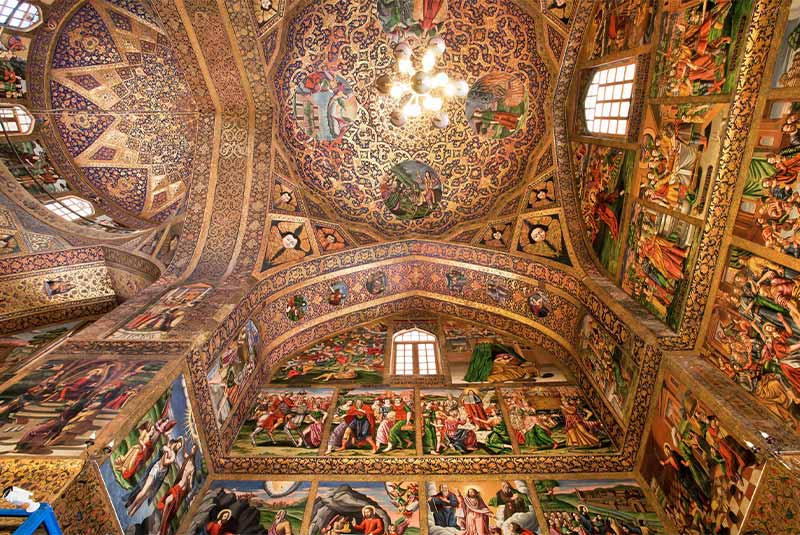
One of the largest and most magnificent Isfahan attractions in the Julfa (Jolfa) area is the Vank Church. Its golden ceiling, dome interior, and exquisite historical artworks are unparalleled. Internally, oil paintings similarly gilded to Iranian art are displayed on the walls. Here, one may see religious artwork with an Italian influence. Shah Soltan Hossain Safavid was the architect of this building. The inside has a wainscot of intricate tile work, magnificent frescos, and gilded embellishments. The central dome's beautifully blue and gold painting represents the Biblical account of the world's creation and man's departure from Eden. The Armenian art motif of a cherub's head encircled by folded wings is painted on pendentives seen throughout the chapel. Persian miniature-style flower designs are delicately painted on the ceiling above the entryway.
11. Isfahan Flower Garden
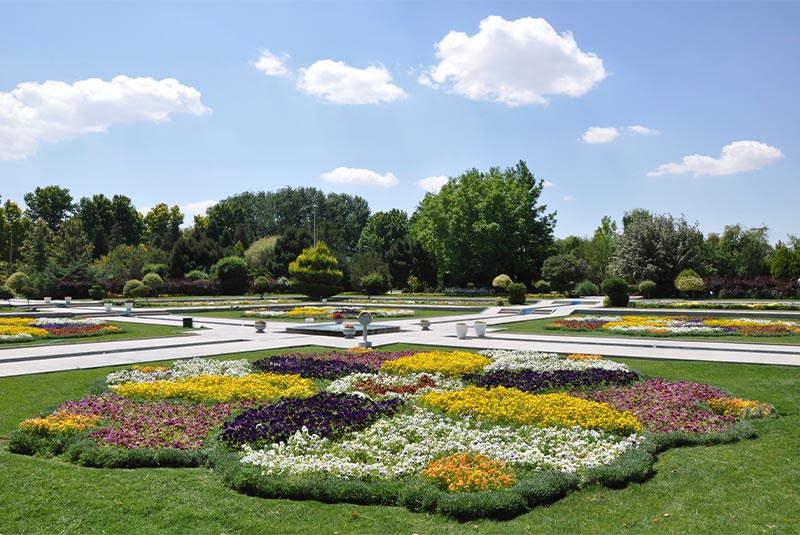
Flowers Garden is one of Isfahan's man-made green spaces and the first Isfahan attraction you must visit during spring. This garden contains a variety of vibrant blooms that are gathered there for visitors to admire and explore. This garden's versatility has enabled it to be utilized and enjoyed by a variety of people. The magnificent architecture of the buildings in this garden draws its inspiration from the traditional Persian style. Additionally, the yard has a beautiful sense of freshness thanks to the lovely decoration of the flowers and plants. Situated near the Zayandehrud River, Salman Farsi Street, and Bozorgmehr Square. The closest bus stop to this garden is the Pol-e Bozorgmehr BRT (Bus Rapid Transit) Station. Joui Bridge, Khaju Bridge, Si-o-se-pol Bridge, Hasht Behesh Palace, Chehel Sotoun Palace, and Naghsh-e Jahan Square are among the surrounding attractions.
The fact that Flowers Garden serves so many different purposes is astounding. It serves a variety of functions, including those related to recreation, culture, education, and research. As a result, families may pass their free time, scientists can finish their studies utilizing the garden's resources, and the city can take in the garden's vibrant beauty. Within the garden's 2,500-meter perimeter, 395 different species of plants have been planted. The Flowers Garden is divided into many areas: an amphitheater, a medical and culinary herb garden, a rock garden, a waterfall, a fountain, a pond, a playground for children, and a rose garden. The designers of this garden drew inspiration from a Persian carpet due to the distinctive pattern of the flowers that makes them resemble a hand-woven Persian carpet in one of the various regions. Each component has unique qualities that you would certainly like.
12. Isfahan Music Museum
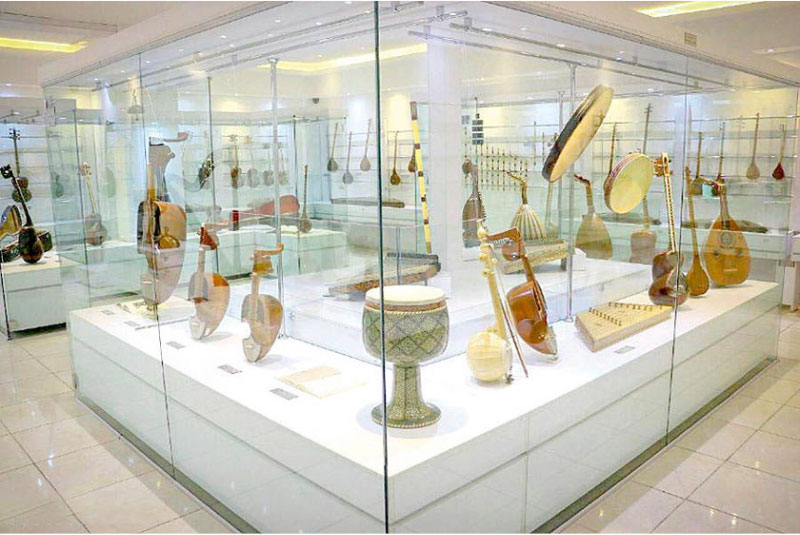
You will navigate the Armenian Quarter in Jolfa homes and feel revitalized as you are surrounded by lovely tall trees that have already created a dreamlike setting for you to be prepared to see this really exceptional museum. Mehrdad Jeihooni and Shahriar Shokrani, two well-known musicians who founded the museum, have collected more than 300 pieces of national and folk musical instruments from all over the world—many of which you may not even be familiar with. This scenario perfectly captures their passion for music. Compared to other Iranian museums, the fee may appear a bit exorbitant, but trust us when we say it is worth it. Since its debut in December 2015, this museum has been not only a tribute to many musical instruments but also a popular destination for musicians and music fans. In one area of the museum, you will enjoy listening to the sublime sound of live music.
13. Julfa

The Armenian neighborhood of Julfa (Jolfa) in Isfahan, Iran, is situated on the Zayande River's south bank. It is still one of the world's oldest and largest Armenian neighborhoods, having been established and named after the ancient city of Julfa, Nakhidjevan, in the early 17th century. The area was established under the reign of Shah Abbas I, who moved a colony of Christians from Jolfa. Julfa is an excellent area to spend a morning browsing the local shops and cafés.
14. Mount Soffeh
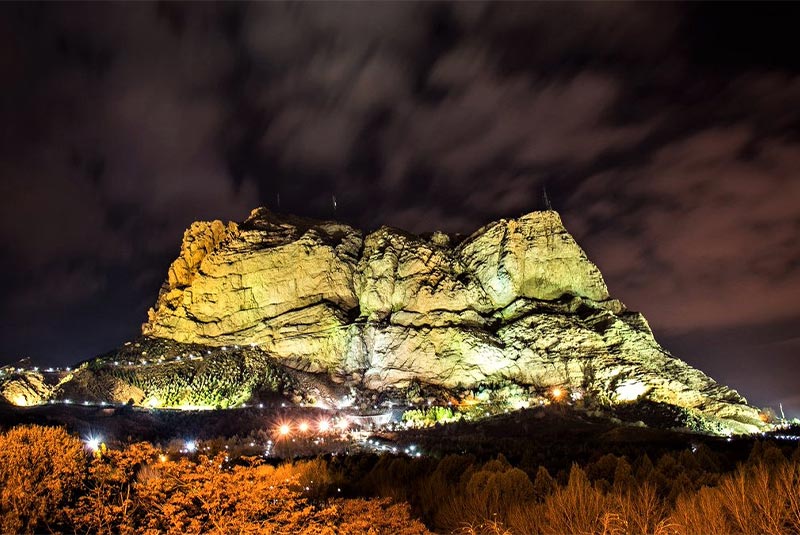
A sturdy, towering mountain guards Isfahan's southern region, serving as its defender. The stunning and well-known Soffeh Mountain, also known as Kuh-e Soffeh, is home to those who seek out a moment to unwind on its verdant hills. At the same time, a chilling breeze caresses their skin, climbers who strive to reach their peak, and visitors come for a brief stroll before taking in the breathtaking views of the city, both during the day and at night. This magnificent mountain is situated in the southern region of the city of Isfahan. Above all, this stunning peak rises to a height of 2257 meters and is a component of the Zagros Mountains. Additionally, several simple and challenging routes up the mountain, and the vistas are breathtaking. Even from a distance, Soffeh Mountain is spectacular. Several lovely waterfalls and caves make this mountain a fantastic spot near the summit.
15. Azadegan Tea House - Chah Haj Mirza
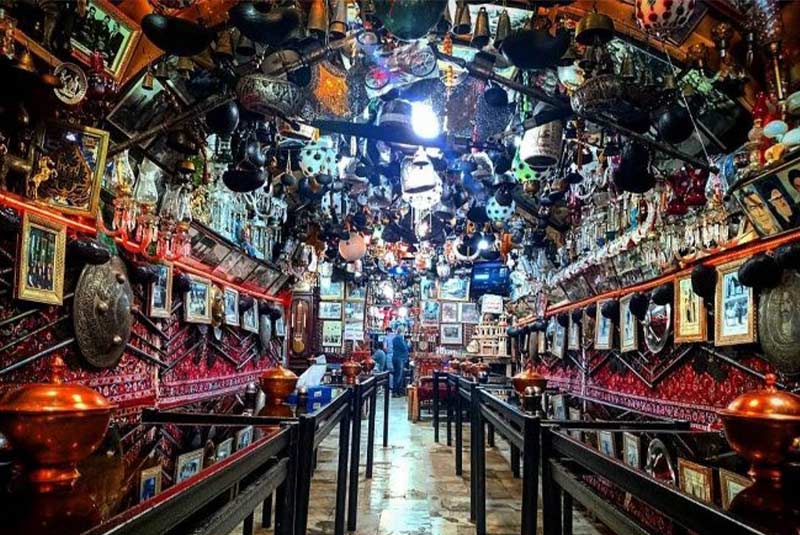
A coffee house with a rich history and antiques, Azadegan Tea House, is one of the world's top tourist destinations. The oldest coffee shop in Isfahan, Chah Haj Mirza, was founded during the Safavid era and resembled a museum. This coffee shop's walls are covered in antiques and artifacts from the era of Taziyeh reading, Shahnameh reading, and storytelling. People who were interested in performing different rituals, such as Muharram, reading the Shahnameh, and reciting the Taziyeh, gave to this coffee shop objects like spears, beds (made of wood), swords, iron caps, valuable stones, paintings, and iron armor. In addition to being stunning in and of itself, this cafe serves tasty Dizi, Doogh, and Gooshfils (Isfahan traditional dessert). The person who owned the place was known by the name Haj Mirza. It's noteworthy to note that this location was known as Khaste Khaneh at the time of its founding and during the Safavid era (a place for tired people). It's also quite obvious why this nomination was made. Men used to frequent this coffee shop to relax and sip tea to help them unwind after a long day.
16. Vartoon Mineral Spring
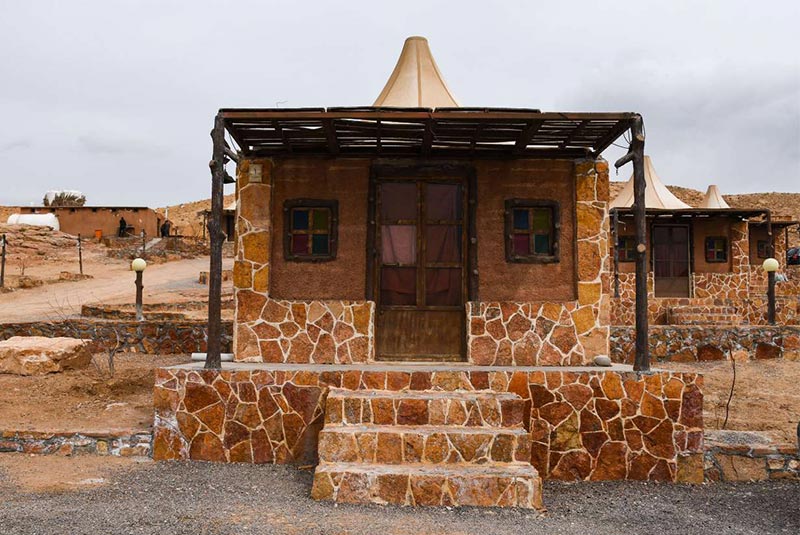
Vartun Springs, also known as Vertoon Mineral Spring, Vartoon Natural Hot Sulfur Springs, and Rose Village, are 43 kilometers southeast of Esfahan (Isfahan) along a branching road at Vertoon. The bicarbonate chloride and calcium sulfate found in Vertoon's thermal spring are effective against digestive problems. Taking a bath in this water is beneficial for treating rheumatic and neurotic symptoms, making this place one of the best Isfahan tourist attractions.
Isfahan Weather; Best Time to Visit Isfahan
Isfahan experiences desert weather. There won't be any rain here any time soon, and the daytime temperature is high. Isfahan has an average yearly temperature of 23 degrees and receives roughly 48 mm of precipitation. With an average humidity of 28% and a UV index of 5, it is dry for 315 days a year. April and May are the best months to visit the attractions of Isfahan, where spring is at its most beautiful dating this period. As a result, Isfahan experiences pleasant weather at this time of year, and its gardens are brimming with lush trees and vibrant flowers. The least popular months for travelers in Isfahan are June, July, and August due to the city's hot and dry summers; therefore, you can visit Isfahan probably with the lowest travel costs. The ideal winter destination for skiers is Isfahan. So, from January to March, you may enjoy skiing in the mountains around Isfahan.
Bottom Line...
Isfahan welcomes a large number of tourists from all around Iran and the world each year because it is a never-ending world of beauty and historical views. We introduced the Top best attractions of Isfahan as briefly as possible and tried to be a guide for tourists before traveling to Isfahan that answers all your questions. We really hope that your visit to the ancient city of Isfahan will be enjoyable and one of the highlights of your life.

